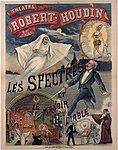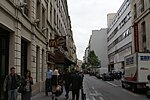The Théâtre Robert-Houdin, initially advertised as the Théâtre des Soirées Fantastiques de Robert-Houdin, was a Paris theatre dedicated primarily to the performance of stage illusions. Founded by the famous magician Jean-Eugène Robert-Houdin in 1845 at No. 164 Galerie Valois as part of the Palais-Royal, it moved in 1852 to a permanent home at No. 8, Boulevard des Italiens. The theatre's later directors, before its demolition in 1924, included Robert-Houdin's protégé Hamilton and the illusionist and film innovator Georges Méliès.
When he first founded the theatre, Robert-Houdin was known primarily for his guest appearances as a magician and his clever mechanical inventions. Eager to solidify his work as a stage performer, he leased assembly rooms in the Palais-Royal and had them converted into a small but elegant proscenium theatre auditorium. In setting his stage, Robert-Houdin deliberately set himself apart from conventional stage-magic traditions; he eschewed the usual emphasis on dazzling visual confusion, replacing it with a simple drawing-room look with light furniture in the Style Louis XV. After a rocky start, his theatre gained critical respect, and boomed in popularity with the introduction of Robert-Houdin's mind-reading illusion "Second Sight".
In early 1852, Robert-Houdin transferred the theatre's directorship to his former pupil Hamilton (born Pierre Etienne Chocat), who continued its success. At the end of that year, when the lease on the Palais-Royal location ran out, Hamilton moved his operation to a boulevard theatre venue on the Boulevard des Italiens. In its new permanent location, the theatre continued to run for the next few decades, under directors including Cleverman (born François Lahire), Pierre Edouard Brunnet, and Émile Voisin. A drastic refreshing of the theatre's repertoire in the mid-1870s gave it a major financial boost, with the added box-office takings allowing it to start hosting guest artists. However, the boom did not last long, and the theatre was physically run-down and in a serious financial slump by the mid-1880s.
In 1888, Georges Méliès took over the lease on the venue. He retained its existing staff but began a thorough revamping, aiming to restore both the theatre's architecture and its repertoire to their former quality. His first major innovation was to conclude each evening's entertainment with a spectacularly staged, lavishly advertised illusion, telling a miniature story complete with original scenery and costumed characters. Méliès's restorations and innovations were a marked success. In 1896, when moving pictures were an emerging novelty, he added film projection to the theatre's repertoire, and even began making his own films to show there and sell elsewhere. Over the next fifteen years, filmmaking became a major part of his career, on top of and overlapping with his work at the theatre. A 1901 fire destroyed most of the venue, but the theatre was rebuilt the same year and continued to present performances with success.
At the onset of the First World War, the theatre was closed; Méliès, now severely in debt from a series of filmmaking-related troubles, was unable to keep it going, and sublet it as a full-time cinema. He shut down the venue in 1923, when he sold all his property in an attempt to pay his debts. Paris city planners demolished the theatre the following year to allow for an extension of the Boulevard Haussmann.










